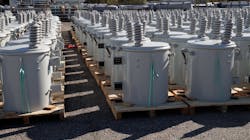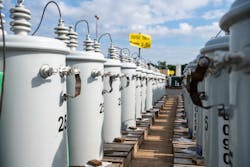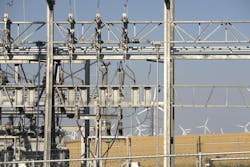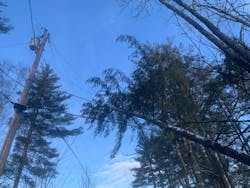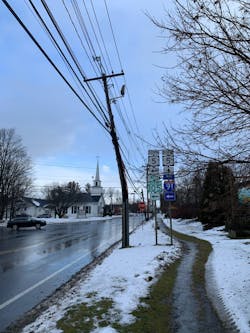No Easy Answers: Transformer Supply Crisis Deepens
“We do not have any timeframe of when to expect deliveries of transformers as suppliers are unable to provide a date of when to expect deliveries to re-start,” according to the announcement. “We apologize for the inconvenience and ask for your patience as this issue is affecting electrical utilities nationwide.”
Reaching out to utilities of different sizes, locations and ownership models, it became clear that the issue was deepening — with wait times growing longer, and shortages occurring with all kinds of transformers, not only the large, pad-mounted variety.
A common refrain from respondents was: We still have some transformers in stock, but an unexpected event could change that, and if it did, it is unclear how we would work around the shortage.
Waiting is the Hardest Part
At Otter Tail Power Co., an investor-owned utility providing service to about 133,000 customers in Minnesota and the Dakotas, utility staff are seeing lead times grow by leaps that would have previously been unthinkable.
“We are delaying some of our underground projects due to the lack of pad-mount distribution transformers on-hand. Lead times are extending to lengths never seen before, we are being quoted a lead time of 202 weeks on pad-mount transformers. That’s 3.88 years,” said Gregory Rausch, sourcing manager for Otter Tail.
It should be noted that the lead time figures provided by Otter Tail were a bit of an outlier, with some utilities that responded to this story seeing shorter wait times and merely concerned about the possibility of longer ones. However, Otter Tail was not unique in wait times lasting multiple years.
Should these trends continue, Rausch said commercial and industrial customers could be impacted, and some new residential customers are already being told they may have to wait longer than normal to be connected to the power grid.
After hurricane season began in the fall, he said, orders were pushed back 2-4 weeks due to transformer makers needing to respond to the demand for transformers in storm-hit areas.
“We can no longer trust manufacturers order ship dates; we don’t plan any projects around the manufacturing ship date because it’s just too unreliable,” he said.
Manufacturers are doing the best they can to communicate when stock will be available, he said, but added that the stress on the supply chain is such that there is no remaining transformer reserve for many utilities to rely on, so that a sudden event like a hurricane can result in even longer delivery times.
“It’s a very serious issue. The chief procurement officers in the Edison Electric Institute companies have been meeting bi-weekly since this spring about the seriousness of this issue,” he said.
According to the EEI, 75% of investor-owned utilities reported having lower reserves of pad-mounted or pole-mounted distribution transformers last year than in 2018. EEI also found it can take two years or longer to source new transformers.
The Electricity Subsector Coordinating Council (ESCC) found last year that 90 percent of investor-owned electric companies reported a “high” or “medium” risk of running out completely of at least one distribution transformer voltage class. About 60 percent of IOUs have had to cancel or put off planned projects due to the shortage, according to ESCC.
Entities representing the industry have called for several remedies, including making funding available to through the Defense Production Act to boost domestic manufacturing, lowering barriers to entry for critical manufacturing jobs, and loosening efficiency restrictions on using different types of transformers in different configurations along the grid.
The American Public Power Association vented its frustration just before the new year when the omnibus appropriations bill, despite calls from the APPA and other trade groups, did not earmark any DPA funding to help ramp up transformer production.
The National Rural Electric Cooperatives Association and the APPA also asked the Department of Energy to temporarily suspend efficiency rules on transformer manufacturers. This change would lower demand for the specially milled steel that manufacturers say is one of the primary drivers of the current product shortage.
Manufacturer’s Take
Back in 2022, Bill Miller, Senior Vice President of Marketing and Sales for Hitachi Energy’s North American transformer business, said the situation had not improved since 2020.
When asked again, Miller now says the situation for manufacturers is changing, with some supply chain issues improving, but he added that the continued scarcity of specially milled amorphous electrical steel in North America is one of the primary drivers for the scarcity of transformers.
Amorphous steel and GOES are made by rapidly cooling a molten alloy so that crystals do not form. This makes a thinner electrical steel that enables lower core losses in a transformer thanks to different magnetic properties in the core, according to Jeremy Dunklin of the American Council for an Energy-Efficient Economy’s Appliance Standards Awareness Project.
Dunklin said the annual domestic capacity of amorphous steel would need to be nearly doubled from 45,000 metric tons to 75,000 metric tons over the next two years to meet the majority of the domestic demand for distribution transformer cores.
“Grain oriented electrical steel continues to be pretty stressed globally,” Miller said, with only one supplier left on the continent. “The demand for the material is still very high. We don’t see that the supply has growing in step with demand. So, if there was any scarcity on supplies for transformers, it would be in the GOES category.”
Meanwhile, China, another of the most important specialty steel makers, is electing not to make as much GOES for export, instead using its own supply domestically.
“China’s zero covid policy was a factor. Over the last 6-12 months, it’s been increasingly difficult to keep the supplies we get from Asia flowing,” Miller said.
Market volatility for transformer oils and copper wire have fallen, providing some relief. Another pressure is now coming from the ongoing chip shortage. The shortage of semiconductor products was a huge pressure on many industries throughout 2022, but now shows some signs of slackening as economic growth plateaus slightly. Miller added that transformers usually do not need semiconductor components unless a customer specially requests them.
Riding the Storm Out
While some utilities are seeing their equipment orders move further down the queue due to severe weather impacts, the situation is also difficult when you are in the path of the storm.
Jay Stowe, CEO and Managing Director of JEA, the municipal utility for Jacksonville, Florida, said his utility is subject to the same long lead times and must plan ahead.
“JEA planned ahead in 2021 to ensure we had transformers for our 2022 storm stock, and we have already placed orders for FY23 storm stock. We also have been able to establish safety stock to make sure we have units on hand for repair and maintenance work. Units received above and beyond those two preventative supply efforts will go to new development projects,” Stowe said.
“We have found various creative solutions to these challenges, including turning to overseas manufacturers for transformers and other supplies, an option that is more costly. Transformer lead times for pad-mounted units have grown from 3 to 4 months prior to the pandemic, to 17 months since supply chain disruptions started in early 2021,” Stowe said.
Besides sourcing items overseas, Stowe said JEA is taking some concrete steps to address the shortages, including ordering more materials to compensate for long lead times, temporarily using overhead transformers in undergrounding applications instead of pad-mounted units, refurbishing transformers in house and “harvesting,” which means redeploying underused transformers. Stowe is also co-chairing an ESCC supply chain “tiger team” of CEOs that is pushing for collaboration across the industry as well as the federal government.
Doubt on Federal Action
While trade groups like the APPA, EEI, ESCC, NRECA and others strive to bring attention to this issue, those on the forefront of the issue are worrying whether the shortage is being looked at with the urgency it deserves.
In Roseville, California, a suburb of the state’s capital, Sacramento, the city-owned Roseville Electric Utility might be having an even tougher time if not for an economic slowdown, inflation, climbing interest rates and the utility’s own careful planning, said Dan Beans, Electric Utility Director.
“We have sufficient reserves to cover the loss of transformers for an estimated two years. We have a small amount in addition to our necessary maintenance reserves to support new construction, but these are limited and depend on the size of the transformer,” Beans said. “With our planning, we have procured what we need for the projects that we know about today, but the next project could be a different story.”
Last year, delivery times for equipment climbed from 3-6 months to more than a year, and worse still, manufacturers offered no guarantee on delivery dates even as transformer prices climbed 40%, Beans said.
“Initially, delivery times for smaller single-phase pad-mounted units were the most impacted, with 3-phase units continuing to go to production in a reasonable time. However, by 2022 Q3, 3-phase units appear to be similarly affected,” he said, adding that the supply problem is spreading to affect other power grid components such as wire and meters.
“I personally visited six congressional offices and none of them were aware of the issue back in June,” he said.
Using the Defense Production Act to boost manufacturing is a good idea, he said, but Congress has so far failed to commit any funding to support the idea even after a year of advocacy from utilities, home builders and other stakeholders.
“Without funding, the DPA is just another acronym and does nothing to help the situation,” he said. “It appears that until customers are not able to have power restored, only then will the government act. Sadly, this will come at a high social, economic, and environmental cost.”
Furthermore, instead of relaxing distribution transformer efficiency standards as the APPA, the NRECA and other groups asked, the DOE issued a noticed of proposed rulemaking December 28 to increase the efficiency of transformers by using even more of the already scarce electrical steel — something Beans said will create a lot of issues.
Dunklin from ACEEE said GOES and amorphous steel each have only a single domestic supplier: Cleveland-Cliffs for GOES and Metglas for amorphous steel. DOE’s proposed rule states that Cleveland-Cliffs does not have the capacity to manufacture high-grade GOES to serve the entire U.S. transformer market, meaning the U.S. is dependent on foreign steel mills. Further, the domestic GOES market is under pressure from the electric vehicle (EV) market as lower grade non-GOES electrical steel is used in EV motors.
Because GOES production can be shifted to non-GOES products at modest cost, many manufacturers have converted GOES production lines to non-GOES to serve the rapidly growing, and more lucrative EV market, meaning that the burgeoning EV market may be in a raw materials competition with the power grid that EVs need to function.
DOE’s proposed standards would essentially require that new distribution transformers use amorphous metal cores starting in 2027, Dunklin said. Absent standards, purchasers would need to start making more purchasing decisions based on total ownership cost and efficiency rather than upfront cost. Dunklin also notes that large transformers are not regulated by the DOE and would not be affected by this rule.
This concept may be a difficult sell for utilities, who are forced to weigh theoretical total ownership cost of equipment against a power grid that can’t be repaired due to transformers being scarce.
“As a department, they appear not to understand or believe the seriousness of this issue. One group from DOE is trying to work with industry to find solutions while others are doing the exact opposite,” Beans said. “It looks like things are going to have to get really bad before the feds will take meaningful action.”
A Storm Strikes
Shortly before the new year, Peter Rossi, COO of Vermont Electric Cooperative was facing down a severe winter storm that would blow through the East Coast and New England that dumped lots of heavy, wet snow on the coop’s service territory.
“The storm was very powerful, about two times stronger than a very similar South/Southeasterly wind event from 2017,” Rossi said. “And it was emotionally draining working long hours through the entire holiday weekend.”
“We were able to stand our system back up in 5.5 days which was a real testament to our preparation, management, and effort by all employees,” Rossi said. “Lots of things went right, and as always, we are analyzing areas for improvement. But a success story is the investments we made in resiliency in certain areas of our system were not affected by outages on this storm. Storm hardening is real and can have a profound impact.”
“But we certainly depleted our stock of overhead transformers that are typical (e.g., 10 KVA and 15 KVA),” Rossi said. “If we have another event this winter, we could be in trouble.”
Building a Way Out
In addition to the de-industrialization of North America that resulted in fewer steel mills, the transformer market itself has changed, Bill Miller with Hitachi said.
“North America is the most active market, depending on who you talk to, for transformers. What’s happening in this market? About 90% of what we sold 10 years ago was to a utility company. Today, only about 60% goes to utilities and the rest will go to others, such as renewable energy developers or property developers who buy directly from the manufacturer,” Miller said.
The customer makeup has changed in the past decade, with much of the growth happening in new areas: Data center hyperscalers, renewable energy projects and the oil, gas and chemical industries, each of which require transformers for their operations.
On the West Coast, the drive for undergrounding to protect the grid from foliage intrusion or sparking wildfires, also requires more transformers. The hurricane-prone East Coast states also have a growing need for transformers as storms intensify, he said.
Hitachi is expanding the manufacturing range and capacity of several of its plants, spending $10 million to modernize its Jefferson City, Missouri factory. More expansions will be announced in the future, Miller said.
T&D equipment manufacturers have to be concerned with how the power grid is holding up, he said, meaning the industry must act as a unit in the common interest of keeping the lights on.
“When [Lee County, Florida] was hit by [Hurricane Ian], we had to reconfigure some of our operations to serve that need. We do prioritize those kinds of disaster conditions to help the area recover from storms, and we don’t charge any extra for that. We do it because it’s the right thing to do,” he said.
Larger utilities often have longstanding relationships with manufacturers, giving them allocated “slots” held for those companies based on their forecasts.
“Now that’s a reliable way to book business. You have a repeat customer with a set rate of growth, you can project the growth of your business,” he said.
Materials shortages caused a lot of jumps in pricing and in delivery scheduling, which makes everything less predictable.
“We used to quote a firm price and ship date. That was during times of more predictable inflation. With the volatility in commodity costs, shipping costs, we moved to variable pricing. For us, we use price adjustment calculation that is typically calculated three months prior to shipping, or about the time we purchase those commodities we need to manufacture it,” he said.
It didn’t used to be necessary to try to predict what a transformer was going to cost in three years, he said. However, now it’s a full-time job trying to keep utility customers informed of these changes.
“That price adjustment method that we use increases transparency for the customer. We are seeing some commodities that are stabilizing in cost,” he said. “So, they can see we aren’t gouging. Some customers get credits if commodity costs fell.”
Markets and geopolitics are difficult to predict reliably, but the industry can rely on two things: People will continue to need electricity and transformers will still be needed to deliver it.
“You can’t trick the physics. We have had these transformers built a certain way for many years, and they were built that way for a reason. You need a certain amount of steel to step up electricity, and you can’t trick the physics,” he said.
One Utility's Strategy
I also talked to my local utility here in Oregon, the Eugene Water & Electric Board, which said they had developed a plan to stay ahead of the issue of supply shortages. EWEB is Oregon’s largest customer-owned utility and provides water and electricity to about 200,000 people — including me — in the Eugene area.
They wanted me to tell you that elements of this piece were originally published in the October 2022 bulletin of the Northwest Public Power Association and was written by EWEB communications specialist.
Silence from suppliers, slippage on orders and increasingly competitive contract bidding – these were the early signs of a supply chain disruption on the horizon.
In the fall of 2021, after a year and a half of leaping hurdle after pandemic-driven hurdle, officials at EWEB realized that supply chain shortages meant the race wasn’t over.
“Our ears perked up and our team jumped into crisis control mode,” said Tyler Nice, EWEB’s electric operations manager.
Like utilities across the nation, EWEB is no stranger to equipment shortages. Below are some stories of how EWEB navigated a tighter market for pad-mounted transformers, cable and smart meter chips.
Tyler Nice, EWEB Electric Operations Manager
In the fall of 2021, we noticed an information shift from reliable suppliers. Delivery estimates were changing. We were accustomed to delivery windows of nine to 12 weeks on transformers from the day we placed the order, and then we were being told it could take up to 38 months.
We collected equipment replacement data from the last three large storms, taking note of what materials we used and the amount we had on hand at the time of the storm. One incident we examined was a large ice storm that, because of its unusual nature, provided good information about what we could expect during an uncommon event. We looked at average yearly totals of equipment failures and replacements. We considered the prior two years of customer-driven projects.
With this data in hand, we could justify placing very large and immediate orders.
Once we had an idea on the quantity of material and equipment we needed, the next step was getting creative with competing contracts. We’re in a seller’s market, which means bids are rising and suppliers have the upper hand in negotiations. Our regular suppliers couldn’t fulfill the large orders we were seeking, so we found new suppliers outside of our normal territory.
We asked ourselves: What are we willing to sacrifice to get the quantity of equipment we need? Quality of transformers has always been very important to us and in the past, we’ve been very selective. But in this market, we had to be more flexible while maintaining contract protection to ensure high value for our customers. We sacrificed some specific technical requirements and settled on some meeting the baseline. But we still ran into some dead ends and turned away a few suppliers for lack of experience in the utility market.
We prepared as much as we could, we got very important orders placed, and now it’s a waiting game. We’re still having regular meetings to strategize our next move and we’re trying to be one step ahead as much as possible. Fortunately, we haven’t materially delayed any customer projects because of lack of equipment, but we have had to phase back some projects.
My advice to another utility would be to listen to the folks on the front lines. Stay open to ideas from your employees in all departments – field crews, design, engineering, purchasing and customer reps. Maintain a space that welcomes unique concepts because it really is a new world and it’s time to start thinking outside the box as we navigate forward.
Bo Mackey, EWEB T&D Apparatus Supervisor
In 2019, we started work on a 10-year capital improvement plan. At that time, we didn’t know a pandemic was around the corner and we didn’t know we’d be facing a very tough supply chain shortage in the coming years. Timing, planning, and a little bit of luck all played a role in putting us in a favorable position for what was ahead.
From 2019 to 2021, our electric capital budget increased significantly by 13% to provide funding for projects such as modernizing information technology, upgrading meters, and replacing aging infrastructure.
Our budget enhancements couldn’t have come at a better time because by fall 2021 we started to hear about extended delivery timelines. We had a robust budget in place when we needed it most and, thanks to our 10-year capital plan, we had already put in the work on strategizing for the big projects over the next decade. We knew we had to start ordering now and not later because delivery estimates jumped from weeks all the way to years in some cases.
Our perspective shifted for how we placed orders. For instance, now we’re placing large orders before we really have the specifics on design and engineering. But we know the plan is set, and that justifies the quantity that we order. This year we were able to secure a five-year contract for 13 large power transformers to support substation rebuilds. We have the confidence to place significant orders like that because even if we don’t use those transformers, it’s still useful for us to have the spare equipment and we’re not losing money. In fact, we’ve already planned for it.
My advice to others is to remember that it’s not business as usual. Maintaining transparency and frequent communication about wait times for equipment with your large customers is important. Like us, they are accustomed to a certain way of doing business and a certain expectation of time frames on projects or repairs. We need to be proactive and keep them informed when those time frames shift.
Crystal Williams, EWEB Distribution Engineering Supervisor
I came into this position in December of 2021, and it’s been full throttle ever since. Our distribution engineering team has really taken the lead on contacting suppliers, doing reference checks, making sure we can meet specifications and then presenting our findings to the purchasing department.
Our goal has been to stay ahead of the issue, and we’ve been able to do that by being creative with our designs and how we use alternative materials. We’ve been able to work closely with the line crews to develop out-of-the-box ways to keep customers connected or to design new connections.
Eugene is expanding rapidly, and it’s been a challenge to make sure we can fulfill those projects on our end. For instance, there are big housing complexes under construction right now and they need large transformers that we just don’t have in supply. Luckily, we have those orders scheduled to arrive this fall and our design techs have been able to partner with customers to phase projects and plan around any impending impacts.
The key has been to keep our customers informed and letting them know we might not be able to start on their project immediately. We’ve made changes to our terms and agreements, including a clause about how project schedules and costs may be susceptible to change because the market is fluctuating so much. So far, our customers understand the issues and they’ve been receptive to change.
My advice for others would be to find alternatives, whether that’s with your equipment suppliers or your designs. Make sure to do your reference checks because not every supplier is the same. When you’re scoping out a new supplier, you’ll want to be as organized as possible beforehand. Do your research on what you’re looking for and be ready for flexibility in your terms and conditions, because if someone out there has the materials you need, then they’re in the driver’s seat. It’s going to be important that you’re ready to buy even if it’s not on the terms you were hoping for.
Frank Lawson, EWEB General Manager
For EWEB, organizational resiliency is the north star of our 10-year Strategic Plan, and not just from the standpoint of operational continuity. Every decision can be evaluated through a resiliency lens, from creating budgets and capital plans with financial headroom, to attracting and retaining diverse and adaptive talent.
But it’s one thing to put words about resiliency into a strategic plan, and it’s another thing to bake resiliency into each business function and to use that plan as a tool to help evaluate tradeoffs between short-term efficiency and long-term value.
I must commend our staff and board of commissioners for operationalizing resilience in a way that allowed us to respond effectively to supply chain shortages. Our board approved a capital plan and budget with the right amount of absorptive capacity, and consistently engages in proactive and future-oriented decision-making. And before supply chain shortages became an industry-wide crisis, our teams pulled together quickly to find opportunities and come up with innovative solutions.
Providing power and water is a 24/7/365 job with no end date, and we must be prepared to deliver those critical services through both stable and unstable periods alike. Resilience in all functions is key to operating in a turbulent environment, whether it be a changing climate, new technology, developing markets, political and regulatory flux, natural and human threats, or evolving diverse community expectations.
About the Author
Jeff Postelwait
Managing Editor
Jeff Postelwait is a writer and editor with a background in newspapers and online editing who has been writing about the electric utility industry since 2008. Jeff is senior editor for T&D World magazine and sits on the advisory board of the T&D World Conference and Exhibition. Utility Products, Power Engineering, Powergrid International and Electric Light & Power are some of the other publications in which Jeff's work has been featured. Jeff received his degree in journalism news editing from Oklahoma State University and currently operates out of Oregon.
